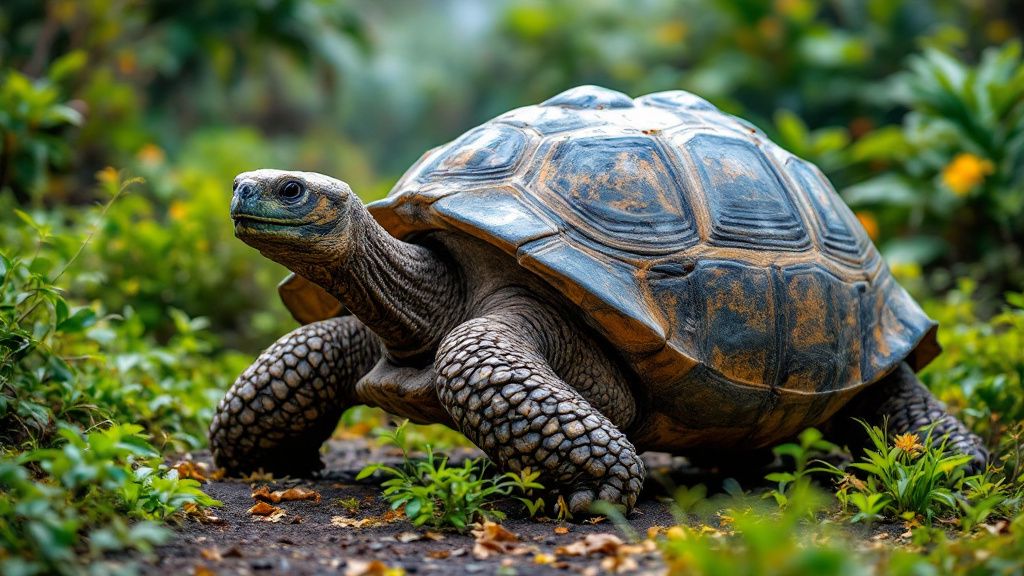
Cloaked in the mystique of the Galápagos Islands, the Galápagos Tortoise stands as a towering figure of evolutionary study, a living testament to nature's awe-inspiring processes. Revered as one of the largest tortoise species globally, Chelonoidis nigra captivates with its sheer size, often weighing in at over 500 pounds and boasting lifespans surpassing a century. This remarkable longevity and imposing presence make the tortoise an integral part of the Galápagos ecosystem, earning it a place of distinction among unique wildlife.
The Galápagos tortoise is more than just a fascinating specimen; it is iconic within the annals of evolutionary history. It played a pivotal role in Charles Darwin's groundbreaking observations during his voyage aboard the HMS Beagle in the 1830s. The variations in shell shape and size among different tortoise populations were instrumental in Darwin's development of the theory of natural selection, underscoring the astonishing ability of species to adapt to their specific environments. These unique animal adaptations exemplify the process of adaptive radiation, with the Galápagos Tortoise standing as a prime example of how organisms diversify to thrive under diverse conditions.
Despite their resilient nature, the Galápagos tortoises are classified as endangered species, largely due to past human activities such as hunting and the introduction of non-native species. Today, a robust framework of animal conservation efforts focuses on ecological restoration, ensuring the survival and continued adaptation of this majestic and unique animal. As stewards of our planet's biodiversity, it is crucial that we value and protect such extraordinary symbols of life's adaptability and endurance.
The Galápagos Tortoise serves as a vivid reminder of the delicate balance within ecosystems and the pressing need to preserve their habitats. As you explore the world of rare animals and unusual animal behavior, the story of the Galápagos Tortoise remains a beacon of hope and a testament to the power of animal discovery, inspiring new generations to champion the rights of all creatures in their bid to preserve our planet's wondrous diversity.
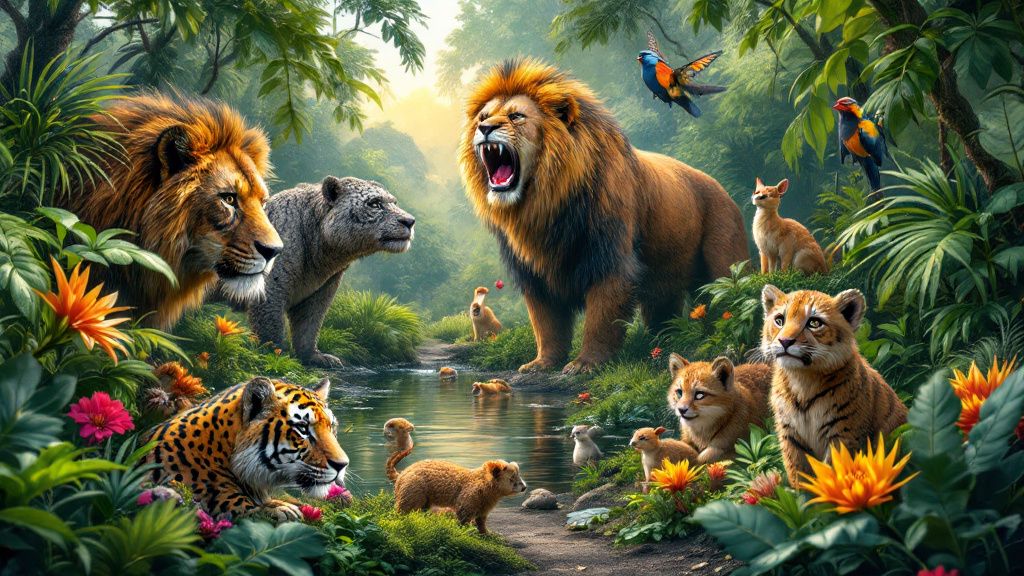
Within the mesmerizing tapestry of nature, exotic animals exhibit an incredible array of adaptations that enable them to flourish under various environmental challenges. Each species, whether it roams the deserts, forests, or oceans, has evolved unique traits that distinguish it from others and enhance its chances of survival.
Consider the chameleon, a master of camouflage. Its ability to change color allows it to seamlessly blend into its surroundings, a remarkable skill that enables it to evade predators. This form of adaptation not only serves as a survival mechanism but also as a testament to the incredible diversity of strategies among unique wildlife.
An outstanding example of nature’s ingenuity is the axolotl, an aquatic salamander known for its regenerative capabilities. This rare animal can regrow lost limbs, providing a substantial advantage in their often perilous habitats. This unusual animal behavior emphasizes the diversity of evolutionary solutions to environmental challenges.
In the blistering Sahara, the Fennec fox’s large ears serve a critical function in dissipating heat, demonstrating how physical adaptations are vital for temperature regulation. Similarly, in frigid conditions, the polar bear’s thick fur and insulating layer of fat are crucial in withstanding the Arctic cold, allowing it to hunt and thrive.
Behavioral adaptations also play a pivotal role in the survival of exotic animals. The Kea, a bird native to New Zealand, showcases impressive problem-solving abilities and agility in accessing food, reflecting both its intelligence and adaptability. Meanwhile, aquatic species like the octopus employ a striking defense mechanism, releasing ink to disorient predators and facilitate escape.
Moreover, the bold coloration of the poison dart frog serves not as mere decoration but as a vivid warning to potential predators about its toxicity—a brilliant example of aposematism. This survival strategy is essential for this small species, making it a formidable player in the complex web of interspecies interactions.
These adaptations speak volumes about the resilience and ingenuity of exotic animals, underscoring the need for their conservation. By understanding these unique animal adaptations, we gain insight into the delicate balance of ecosystems and the extraordinary lengths to which nature will go to ensure survival. As we embrace the role of protecting these uncommon pets and peculiar creatures, we support the intricate dance of life that unfolds across our planet.
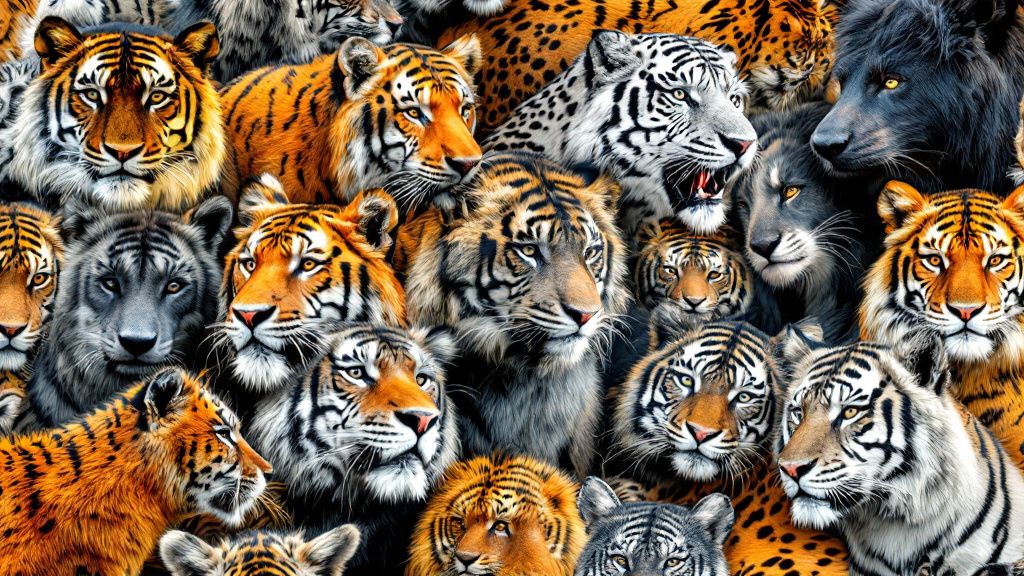
In today’s rapidly changing world, unique wildlife patterns are emerging with both alarming and hopeful trends. These shifts in animal populations are intricately connected to factors like climate change, habitat destruction, and conservation efforts, reshaping our understanding of endangered species and the mysterious world of strange animals.
Global warming has emerged as a formidable challenge, causing habitat loss and altering species distributions. For instance, the melting sea ice driven by rising temperatures is negatively impacting polar bear populations, risking their survival as they lose their primary hunting grounds. Such changes necessitate urgent attention to climate-related effects on unique wildlife.
Another pressing issue is the continuous habitat destruction resulting from urbanization and agricultural expansion. Nearly a million species face the threat of extinction, with human activities at the core. This environmental upheaval signals the urgent need for innovative conservation solutions to safeguard these vulnerable populations.
The illegal wildlife trade remains a grave concern, contributing significantly to the decline of species such as elephants and rhinos. Poaching for ivory and horns has drastically reduced their numbers, with many populations seeing dramatic declines of over 50% in recent decades. This grim reality highlights the critical need for stricter enforcement against illegal poaching and greater support for animal rights organizations.
Embracing technology has become a beacon of hope in conservation efforts. Employing drones and camera traps has revolutionized monitoring practices, enabling the protection of species like the Sumatran tiger from poachers. Such advancements offer promising tools to track changes in rare animal populations and bolster our efforts to preserve them.
Success stories, like the unprecedented rebound of the California condor, illustrate the positive impact of comprehensive conservation strategies. From just 27 individuals in the 1980s to a thriving population of over 500, their recovery underscores the effectiveness of captive breeding and long-term ecological studies in reversing the fortunes of endangered species.
Invasive species pose another threat, as they often outcompete native wildlife for resources, leading to declines in indigenous populations. The brown tree snake in Guam serves as a stark example, having driven several native bird species to extinction. This situation calls for heightened vigilance to prevent further introduction and spread of such species.
These patterns in unique wildlife today redefine how we perceive endangered species, demanding multifaceted approaches to conservation. Through understanding and addressing the complex interplay of these factors, we aim to protect and preserve the incredible diversity of life that enriches our planet.
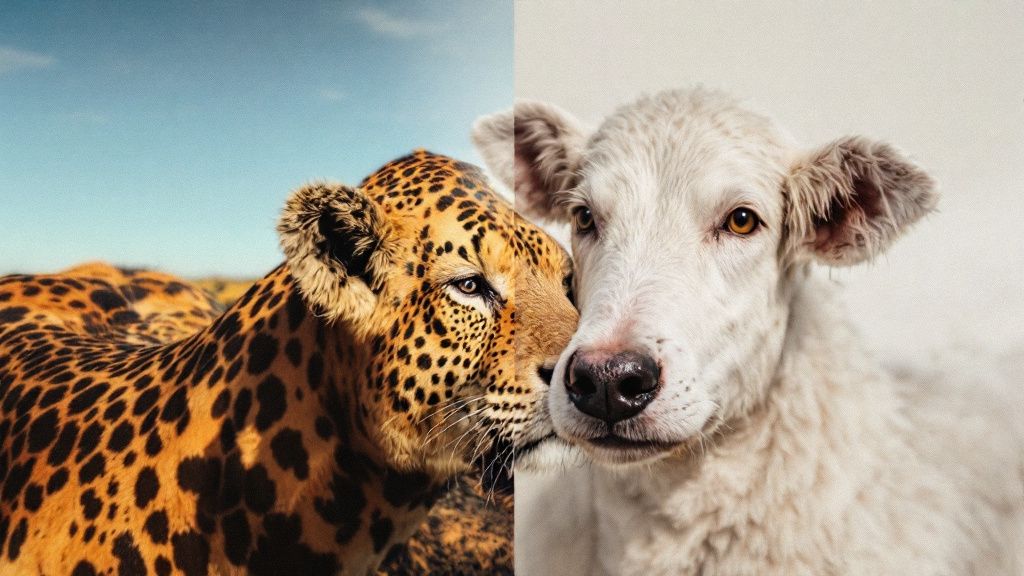
Challenging prevailing beliefs about unique animals invites us to reexamine the ethical implications and overlooked truths surrounding their roles and conservation. While the allure of exotic pets seduces many into bringing reptiles, primates, and other unique animals into their homes, it's vital to acknowledge the ethical concerns that arise when these creatures’ psychological and physical needs go unmet. The exotic pet trade, bustling with an estimated 30 million trafficked creatures annually, significantly undermines wildlife populations and biodiversity, laying bare the tenuous link between domestication and genuine conservation efforts.
A common misconception within animal conservation is the overreliance on captive breeding programs as a panacea for saving endangered species. While these efforts are important, they must be accompanied by robust habitat preservation and restoration initiatives to ensure meaningful recovery. The reestablishment of natural ecosystems is indispensable for the long-term survival of these species, a truth often overshadowed by the allure of behind-the-scenes breeding success stories.
Among the more controversial ideas is the notion that owning exotic pets can foster conservation by increasing public awareness. While this argument has merits, it risks inadvertently supporting illegal wildlife trades and further endangering species. True conservation requires stringent regulation and public education about the roles these animals play in their natural habitats, rather than glamorizing their status as uncommon pets.
Another divisive topic is the ‘rewilding’ of domesticated animals like dogs and cats. While well-intentioned, this approach can disrupt local ecosystems and wildlife, invoking unforeseen consequences that underscore the necessity of deliberate and informed rewilding strategies. Each animal, whether domesticated or exotic, fulfills a unique ecological role, and reshaping these roles can have a cascading impact on biodiversity.
By questioning these popular beliefs, we open a dialogue on the authentic duties of conservation and the ethical stewardship of exotic animals. Through understanding and conscious efforts, we can align public perceptions with practices that honor both the welfare of individual animals and the greater ecological tapestry they inhabit.
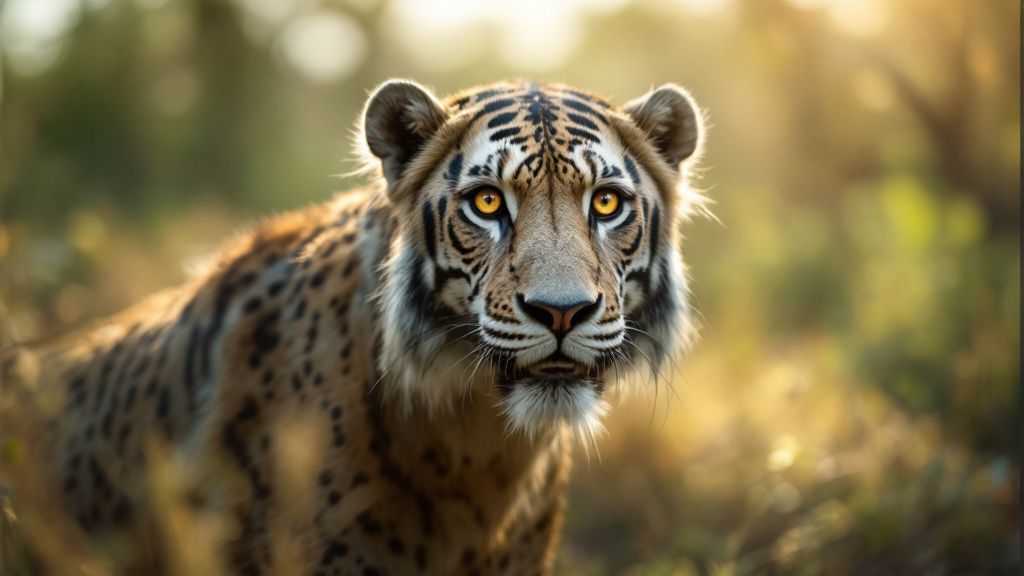
Diving into the world of wildlife exploration reveals a complex and often unseen tapestry of efforts underpinning animal discovery and conservation. This demanding field blends innovative technology and traditional research methods, creating a multifaceted approach to understanding and protecting unique wildlife.
Researchers employ varied strategies such as field surveys, remote sensing, and genetic analysis to collect crucial data about animal populations and their habitats. Yet, these scientific pursuits are fraught with challenges. Habitat destruction, climate change, and funding shortfalls continually challenge scientists, while remote and inaccessible locations exacerbate logistical difficulties in studying certain rare animals.
Hidden behind conservation success stories is the indispensable role of community engagement. Local populations frequently play a pivotal part in conserving their native ecosystems. Successful wildlife management must account for socio-economic factors, acknowledging that conservation is as much about people as it is about animals.
The triumphs of wildlife exploration are frequently rooted in technological innovation. Tools like drones and camera traps have revolutionized research, enabling scientists to observe animal behavior and track populations with minimal ecological disruption. These devices open up new vistas of understanding, offering glimpses into the lives of animals previously concealed by dense foliage or harsh terrain.
Citizen science has evolved into a cornerstone of contemporary wildlife research, galvanizing public involvement and enriching professional datasets with firsthand observations. This democratization of scientific contribution not only aids researchers but also amplifies public consciousness of conservation challenges, fostering a collective responsibility for wildlife preservation.
Amidst these advancements, the heartbeat of wildlife exploration remains the unwavering determination of researchers to overcome obstacles and illuminate the intricate workings of nature. Their victories, often quiet and behind-the-scenes, are profound, ensuring the continued splendor of the earth’s diverse and irreplaceable life forms.
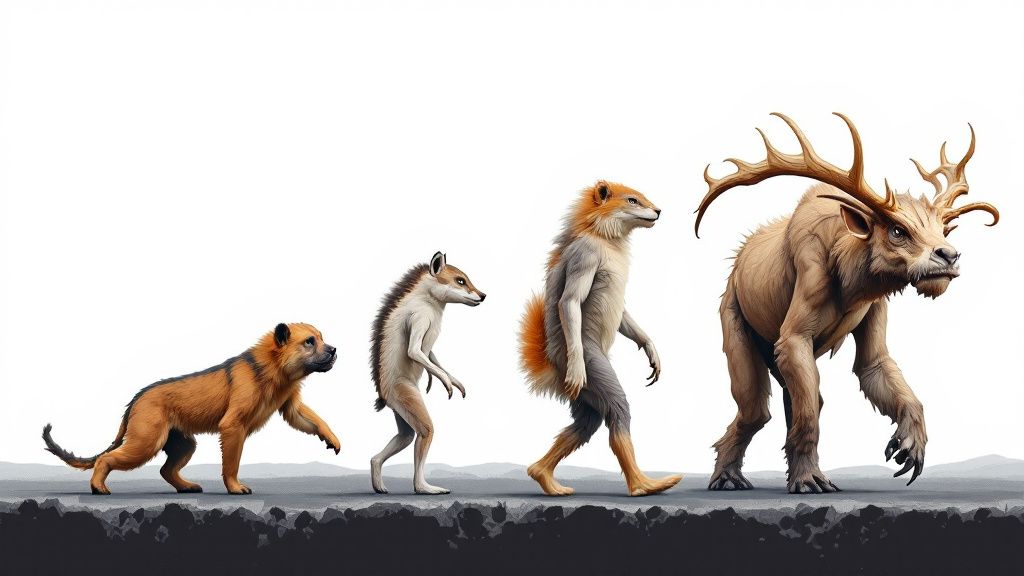
A comparative analysis of the Galápagos tortoises and the Komodo dragon offers a fascinating glimpse into the diverse paths of evolution, revealing how each species has uniquely adapted to its environment. Both represent unique wildlife, yet their evolutionary histories have crafted markedly different survival strategies and adaptations.
The Galápagos tortoises, belonging to the species Chelonoidis nigra, have evolved to meet the demands of life on the Galápagos Islands. Their adaptations include an impressive size and longevity, with some living over a century. These features enable them to endure the island's challenging conditions, where food availability is often seasonal. Their morphological diversity, particularly in shell shapes, exemplifies the theory of adaptive radiation. This diversification allowed different tortoise populations to exploit various ecological niches across the islands, demonstrating nature's resourcefulness in addressing scarcity and environmental variation.
In contrast, the Komodo dragon, Varanus komodoensis, thrives as an apex predator in its habitat, reflecting a different evolutionary approach. Known as the largest lizard species, Komodo dragons possess a formidable arsenal of adaptations that include a potent bite and venomous saliva, which are critical for subduing prey much larger than themselves. This predatory prowess positions them at the top of the food chain, with relatively stable morphology that underscores their specialization and competitive adaptations within their ecosystem.
While both species have followed divergent evolutionary paths, their current challenges mirror each other. The Galápagos tortoises are threatened by habitat loss and competition from invasive species, while the Komodo dragons face mounting pressures from climate change and poaching. Each species' survival now depends on ongoing conservation efforts designed to safeguard their habitats and address human-induced threats.
The story of the Galápagos tortoises and the Komodo dragon highlights the diverse strategies species employ to adapt to their environments. Through understanding these evolutionary tales, we gain insight into the complex dynamics of life on Earth, emphasizing the importance of preservation efforts to maintain their extraordinary legacies.
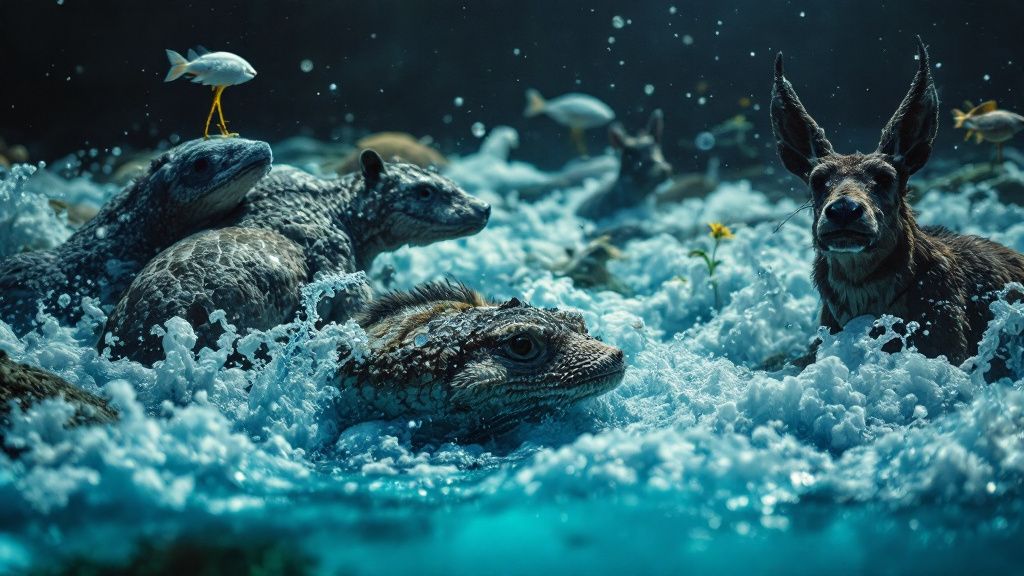
Exploring a unique perspective on animal habitats reveals the profound influence these environments exert on rare animals and their distinctive behaviors. From the vibrant depths of coral reefs to the dense, lush expanses of rainforests and the stark, icy majesty of the arctic tundras, each habitat supports a rich tapestry of life meticulously adapted to its surroundings.
Rare animals find their niches within these unique habitats, each driven by natural selection to develop traits that enhance survival and reproductive success. Camouflage, specialized foraging strategies, and intricate social structures are just a few examples of unusual behaviors that have evolved in response to environmental demands. Such adaptations underscore the critical role habitats play in shaping the lives and survival strategies of their resident species.
Conservation efforts that focus on protecting these unique ecosystems are essential for species preservation. The Amazon rainforest, for example, is a biodiversity hotspot, home to myriad endemic species that cannot exist elsewhere. Preserving such habitats is vital not only for maintaining ecological balance but also for ensuring the survival of the rare animals that depend on them.
The urgency of habitat conservation is starkly highlighted by the IUCN Red List, revealing that habitat destruction threatens over 1 million species with extinction. Addressing this looming crisis requires robust conservation actions aiming to halt and reverse the loss of these critical environments.
Effective conservation strategies often include engaging local communities and leveraging traditional ecological knowledge. Such inclusive approaches recognize the invaluable insights and stewardship roles of indigenous and local populations, leading to more sustainable and successful preservation efforts. Protecting unique habitats is not only a biological imperative but a cultural one, ensuring that both wildlife and human communities can continue to thrive.
The vibrant array of life supported by these unique habitats enriches our planet and elevates our understanding of biodiversity. By appreciating the critical connections between species and their environments, we can foster a deeper commitment to preserving the wild spaces that nurture life's incredible diversity.
Get free resources, early access to new features and updates.
No spam. Just fun educational emails!